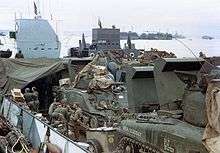LCT 7074
| Class overview | |
|---|---|
| Builders: | Hawthorn Leslie and Company |
| Operators: |
|
| Built: | 1944 |
| In service: | 1944-45 |
| Completed: | 235 |
| Preserved: | 1 |
| General characteristics | |
| Displacement: | 640 long tons (650 t) |
| Length: | 192 ft (59 m) |
| Beam: | 30 ft (9.1 m) |
| Draught: | 3 ft 10 in (1.17 m) (forward) |
| Propulsion: | 2 × 460 hp (343 kW) Paxman diesels or Sterling petrol engines, 2 shafts |
| Speed: | 9 knots (17 km/h; 10 mph) |
| Range: | 2,700 nmi (5,000 km) |
| Capacity: | 300 long tons (305 t) of cargo |
| Complement: | 12 |
| Armament: | 2 × single 2-pounder pom-pom or 2 × single Bofors 40 mm guns |
| Armour: |
|
LCT 7074 is the sole surviving British Landing Craft, Tank (LCT), an amphibious assault ship for landing tanks on beachheads. Built in 1944 by Hawthorn Leslie and Company, Hebburn, the Mark 3 LCT 7074 was part of the 17th LCT Flotilla during Operation Neptune, the naval dimension of the D-Day landings in June 1944. The vessel was decommissioned in 1948, and presented to the Master Mariners' Club of Liverpool to be used as their club ship and renamed Landfall.[1] Later converted into a floating nightclub, the vessel was acquired by the Warship Preservation Trust in the late 1990s and was moored at Birkenhead. The vessel was raised in October 2014 and transported by sea to Portsmouth for restoration.[2]
Design
Initially developed by the British Royal Navy and later by the United States Navy during World War II into a number of different versions. Initially known as the "Tank Landing Craft" (TLC) by the British, they later adopted the American nomenclature "Landing Craft, Tank" (LCT). LCT 7074 was one of 235 LCT Mark 3’s. The vessel was built by Hawthorn, Leslie and powered by American Sterling Admiral petrol engines. Launched on 30 March 1944, the vessel was commissioned into the Royal Navy shortly afterwards.
D-Day
LCT 7074 would have had two officers and 10 ratings and she was first commanded by Sub Lt John Baggot RNVR who sailed the vessel to Great Yarmouth where she joined the 17th LCT Flotilla. In the build-up to D-Day, LCT 7074 arrived at the River Orwell, near Felixstowe where she was loaded with 10 Sherman tanks. As part of the 17th LCT Flotilla (Assault Group L2), LCT Squadron "H" of the Eastern Task Force, LCT 7074 successfully landed nine of the tanks on Gold Beach.

Following the invasion, the craft spent several months making 32 round trips ferrying vehicles, troops, supplies and ammunition across the Channel.[3] LCT 7074 was initially to undergo a change of use to become an emergency repairs ship for use in the Far East. However, although her designation changed to NSC L (19) the end of the war in the Pacific saw this abandoned.
De-commissioned in 1948 she was renamed Landfall and became the club ship for Master Mariners’ Club of Liverpool. The craft was later converted into a riverfront nightclub. In the lates 1990s, the Warship Preservation Trust acquired LCT 7074 and undertook minor restoration work but when the trust went into liquidation in January 2006, all restoration stopped.[4]
Much of LCT 7074's superstructure is original to her 1944 build, however, her engines had been removed and will need to be replaced.
Salvage, restoration and display
LCT 7074 was partly submerged at its mooring at East Float in Birkenhead, but following a £916,000 grant from the National Memorial Heritage Fund (NHMF), the craft was salvaged during a two-day operation on 15 and 16 October 2014. The operation started on 22 August 2014. Over 100 dives by Liverpool diving company Salvesen UK Ltd were required to enable her to be refloated. The LCT was raised and floated into the hold of the MV Condock, which transported the LCT to the BAe Systems Naval Dockyard, Portsmouth to undergo restoration.[5] LCT 7074 will be stored in the main ship hall at Portsmouth and to prevent further corrosion occurring the craft will be treated with a stabilising wax. The vessel will be subsequently restored once additional funds have been secured.[6]
Following restoration LCT 7074 will eventually go on display at Portsmouth's D-Day Museum to coincide the 75th anniversary of D-Day in 2019.[7]
Carole Souter, chief executive of NHMF, said it was "fitting" that it was able to save "one of the last remaining of 7,000 ships that took part in D-Day, the largest ever seaborne invasion and a significant moment in UK and world history".
References
- ↑ "Landfall". National Historic Ships UK. Retrieved 16 October 2014.
- ↑ "D-day tank carrier Landfall refloated for restoration". Guardian News and Media Limited. Retrieved 16 October 2014.
- ↑ "Liverpool Bids a Final Fond Farewell to D-Day Landing Ship". War History Online. Retrieved 16 October 2014.
- ↑ "Landfall". National Historic Ships UK. Retrieved 16 October 2014.
- ↑ "Historic landing craft LCT 7074 is coming to Portsmouth!". Portsmouth’s D-Day Museum. Retrieved 5 January 2015.
- ↑ "LCT 7074: THE LAST D-DAY LANDING CRAFT RE-FLOATED". Artelia international. Retrieved 2 January 2015.
- ↑ "D-Day landing craft raised from dock". BBC News. Retrieved 2 January 2015.
External links
| Wikimedia Commons has media related to Landing Craft Tank. |
- LCT 7074 re-float time-lapse at Birkenhead
- Photo archive organized by individual ship
- LCT History
- Memories of Landing Craft
- Landing Craft Tank Squadron by Lt-Cdr. Maxwell Miller